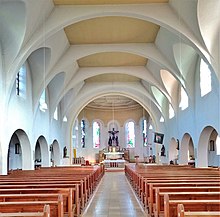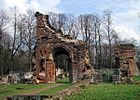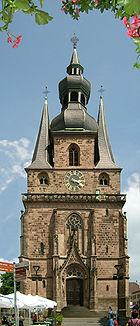List of churches and monasteries in Saarland
List of church buildings in Saarland by district |
The Saarland has around 390 Catholic and 140 Protestant churches as well as numerous chapels and isolated church buildings of other denominations. The following is a brief introduction to the history of church building in Saarland and a list of some of the outstanding structures. A complete listing of all church buildings in Saarland can be found under the linked lists on the adjacent map.
Historical, architectural styles and architects
The oldest preserved sacred building in Saarland is the old tower in Mettlach, which was built around 994 as an Ottonian burial chapel for St. Lutwinus. The octagonal building is closed by a simple vault and has some structural similarities to the Aachen Palatine Chapel . In addition, there is a Romanesque village church from the 12th century in Böckweiler . In the Saarland, the Benedictine Abbey Tholey , first mentioned in 634 AD, is also the oldest verifiable founding of a monastery on German soil. Today's early Gothic abbey church dates from the 13th century. In the district town of St. Wendel there is a large late-Gothic hall church, which was built as a grave and pilgrimage site of Saint Wendelin and served as a model for the interior design of later neo-Gothic parish churches in the region.
In both major denominations, the baroque or classicist hall church type, which is accompanied by a flat ceiling over a single-nave church, is widespread to this day. The transition from the walls to the ceiling is often rounded and colored. Otherwise these churches are relatively simple in contrast to the richly furnished baroque churches in southern Germany. Classic representatives of these hall churches, which are typical for the region, can be found in Him , Wadern and Kastel . In the south of the state, which has long been Protestant, there are also some noteworthy church buildings by the well-known baroque architect Friedrich Joachim Stengel . B. the Ludwigskirche or the Friedenskirche in Saarbrücken . The Evangelical Church in Bischmisheim , built between 1822 and 1824 according to plans by Karl Friedrich Schinkel , is considered one of the outstanding representatives of classicism in southern Germany .
Numerous large village and town churches were built in a building boom around 1900 and are stylistically completely committed to historicism . Not infrequently they served as a substitute for the small hall churches that were no longer able to cope with the increasing number of believers, and so it happened that representative, predominantly neo-Gothic, but also neo-Romanesque or neo-baroque church buildings were built even in the country. The most common type of this time is the three-aisled neo-Gothic hall church with colored cross ribs , pillars and services . One of the most frequently represented architects of historicism in Saarland was Wilhelm Hector .
In the years between the great world wars, some expressionist buildings were built, such as the large St. Michaels Church in Saarbrücken (architect: Hans Herkommer ) or the numerous churches of the Ludwig Becker & Anton Falkowski consortium from Mainz . Overall, the church buildings of this era can be assigned to abstraction historicism , which combines the type of the traditional Romanesque basilica or baroque hall church with a clear geometric design language.
A second building boom started after the Second World War and lasted until around the 1970s. Reasons for this were, among other things, the reconstruction after the war, the strong birth cohorts and the construction of new settlements, which made it necessary either to enlarge the existing church building or to found a new parish. In many cases, the existing historicizing church buildings from the turn of the century were enormously expanded by additions in the style of the time. Examples of this are the parish churches in Hasborn-Dautweiler , Freisen and Kirrberg . In the 1960s, church buildings in the style of brutalism , such as For example, the parish church of St. Ludwig zu Saarlouis designed by Gottfried Böhm , whose formal language is in tradition with the famous Neviges pilgrimage cathedral. Böhm also designed the churches of St. Albert in Saarbrücken and St. Hildegard in Neuweiler . By Rudolf Schwarz , the design for the light-filled parish church dates Mary Queen in Saarbrücken on the shape of a Latin cross with parabolic arms.
After this building boom subsided, only a few church buildings were built in Saarland. With St. Johannes in Saarlouis's Steinrausch district, a modern church and community center in the style of the 1980s was built. The most recent church buildings to date were completed in 1998 in Obersalbach and in 2000 in Ludweiler . Both cases are replacements for church buildings that had to be abandoned due to mining damage. In addition, the ailing Catholic Church of St. Johannes from the 1960s in Wellesweiler was replaced by a new building in 2011.
Since the turn of the millennium, individual church buildings have been profaned or deedicated in Saarland. The reasons for this are demographic change and the regressive number of church visitors. The church congregations of both denominations, which were founded in new housing estates in the middle of the 20th century, are particularly affected by this. Examples for this case are the churches of St. Mauritius in Saarbrücken , St. Elisabeth in Riegelsberg and the Evangelical Church of Oberlinxweiler . In 2015, the district town of Neunkirchen was hit by a large wave of profanation when seven churches in the city area (including three Catholic and four Protestant) were deedicated within one year.
List of important sacred buildings
Church buildings or items of equipment of art historical importance are listed, the most notable buildings and items of equipment are highlighted in bold .
* = Monastery or former monastery
Merzig-Wadern district
- Bardenbach , Wadern (from 1770)
- Marzellus Chapel, Beckingen (1634)
- Bietzen, Merzig ( picture ) (1930–1932, high altar 1731)
- Brotdorf , Merzig (1931/32 by Clemens Holzmeister )
- Dagstuhl Castle Chapel , Wadern (1763)
- Luziakapelle Erbaren, Beckingen (1772)
- Fitten, Merzig (1724)
- Ludwigskapelle Gehweiler, Wadern (18th century)
- Honzrath , Beckingen (17th century)
- Keßlingen , Perl (15th century choir, nave 1779)
- Kostenbach , Catholic parish church Herz-Jesu ( Neo-Romanesque old building (nave) 1887–1889 by Wilhelm Hector , modern new building (transept) 1968–1972 by Peter Van Stipelen)
- Lockweiler, Wadern (roman tower)
- Merchingen , Merzig (1929/30 by Clemens Holzmeister )
- St. Peter *, Merzig , former Premonstratensian penitentiary sk. (around 1200)
- Kreuzbergkapelle, Merzig (crucifixion group 1712)
- Old Tower *, Mettlach, former Benedictine abbey (10th century)
- Mettlach Abbey * , Mettlach (from 1728 according to plan BC Kretschmar)
- Mettlach, Lutwinus Church, cross reliquary (13th century)
- Nohn, Mettlach (high altar around 1700)
- Orscholz , Mettlach (1830/31, classicistic)
- Rimlingen , Losheim (1744 with Roman tower)
- Saarfels, Beckingen , St. Barbara Chapel (15th century)
- Saarhölzbach , Mettlach (1792, expanded 1848, furnishings 18th century)
- St. Gangolf *, Mettlach (1775, Capuchin monastery since 1900)
- Tettingen-Butzdorf, Perl (1851, alabaster reliefs by HR Hoffmann )
- Wadern (1817, Roman tower, alabaster relief by HR Hoffmann )
- Wadrill, Wadern (roman tower)
- Wahlen , Losheim (around 1750, extended 1927/28, furnishings 18th century)
- Wehingen, Mettlach , chapel (1733, altar 1775)
- Weiskirchen (1830–1833, classicist)
- Wochern , Perl (1789, Gothic choir)
Neunkirchen district
- Dirmingen, Eppelborn (Roman. Tower, 1746 reconstruction by FJ Stengel )
- Eppelborn (14th century / 1760, later changed several times)
- Fürth , Ottweiler (Gothic tower)
- Heiligenwald, Schiffweiler , Protestant prayer room church (1866)
- Illingen (choir tower 13th century, ship 1789–1791)
- Mountain chapel , Illingen (16th century, rebuilt in 1901)
- Neumünster *, Ottweiler , former Benedictine convent (founded in 1005, Romanesque building remains)
- Ottweiler , Protestant church (16th century with Gothic choir and tracery, reconstruction of 18th century tomb Count Walrad † 1705)
- Wellesweiler , Neunkirchen, old Protestant church (1757)
- Wiesbach , Eppelborn, Valentinus Chapel (1796)
Regional association Saarbrücken
- Altenwald, Sulzbach, ev. "Prayer Hall Church" (end of the 19th century)
- Aschbachkirche, Gersweiler , Saarbrücken (ruin, Roman core.)
- Kuchling Chapel, Auersmacher, Kleinblittersdorf (18th century)
- Bischmisheim, Saarbrücken, Protestant Church (1822–1824 after Pl. Von Schinkel )
- Bliesransbach , Kleinblittersdorf, church (1779), Wendalinus chapel (1736)
- Bübingen, Saarbrücken (Roman tower, ship around 1700)
- Old Tower Dudweiler , Saarbrücken (tower, 14th century)
- Ensheim *, Saarbrücken, former provost office of Wadgassen (church sold)
- Laurentiuskapelle, Eschringen , Saarbrücken (Romanesque core)
- Fechingen, Saarbrücken (Roman tower and lintel)
- ev. Gersweiler Church , Saarbrücken (1784)
- Heusweiler (15th century choir)
- Martinskirche Kölln, Köllerbach (13th – 15th centuries)
- Ludweiler , Völklingen, Protestant Church (1786/67)
- "Köllertaler Dom" (St. Sebastian) , Püttlingen (1908/09 by Wilhelm Hector )
- Saarbrücken :
- Deutschherrenkapelle (13th century)
- Castle Church (15th century, tombs of the counts and princes of Nassau-Saarbrücken )
- Ludwigskirche ( FJ Stengel , 1762–1775)
- Friedenskirche ( FJ Stengel , 1743–1751)
- Old Protestant Church of St. Johann (18th century)
- ev. Johanniskirche (1894–1898 by Heinrich Güth)
- St. John's Basilica ( FJ Stengel , 1754–1758)
- St. Michael , St. Johann (1923–1924 by Hans Herkommer )
- St. Albert , Rodenhof (1952–1954 by Dominikus Böhm )
- St. Arnual *, Saarbrücken, former collegiate church (14th century, tombs of the Counts of Saarbrücken)
- ev. church in Sulzbach (1852-1854 based on the Apollinariskirche / Remagen, expanded in 1897/98)
- Völklingen , Protestant Reconciliation Church (1926–1928)
- Völklingen , cath. St. Eligius Church (1912/13 Ludwig Becker )
- Wintringer Chapel, Kleinblittersdorf (15th century)
Saarlouis district
- St. Matris Dolorosae, outside, Schmelz (Roman. Choir tower)
- St. Martin, Berus , Überherrn (15th, 17th – 19th centuries)
- St. Peter, Bisten , Überherrn (1780–1788)
- " Saardom ", Dillingen (1910–1913), largest church in Saarland, with triptych (16th century)
- St. Johann , Dillingen (built 1845, reconstruction 1948)
- St. Marien , Ensdorf (1863–1868 by Alexander Himpler )
- Abbey Fraulautern *, Saarlouis , former Augustinian convent (founded 1129)
- St. Mauritius, Fremersdorf , Rehlingen-Siersburg (1911/12 in "Staufer style")
- Heiligenborn *, Bous, Redemptorist Monastery (1949)
- St. Nikolaus , Hemmersdorf , Rehlingen-Siersburg (15th century choir, 18th century nave)
- St. Hubertus, Him , Wallerfangen (Roman tower, ship 1726–1732)
- St. Martin in Itzbach, Rehlingen-Siersburg (1758, 1912)
- Holy Trinity and St. Marien , Lebach
- Limbach, Schmelz (Roman choir tower)
- St. Crispinus and Crispinianus , Lisdorf , Saarlouis (1764; expanded in 1929)
- St. Medardus, Neuforweiler , Saarlouis ( picture ) (1864–1866 by Alexander Himpler)
- St. Blasius , Saarwellingen (1898–1900 in neo-Gothic style)
- St. Pius , Saarwellingen (1959–1960 by Toni Laub)
- St. Marien , Saarwellingen-Reisbach (1885–1887 in neo-Gothic style, oldest existing church in Saarwellingen) with historical Klais organ from 1900
- St. Bartholomäus , Saarwellingen-Schwarzenholz (1914–1916 as a neo-Gothic hall church) with a medieval baptismal font in the entrance area
- Orannakapelle, Berus , Überherrn (13th century core)
- St. Maximin (Leases) , Dillingen (Roman. Lintel in the neo-Gothic church)
- Canisianum *, Saarlouis, former Augustinian monastery (founded 1691, new chapel 1901)
- St. Willibrord, Siersdorf, Rehlingen-Siersburg (Roman tower, ship 1523)
- St. Antonius Chapel, Überherrn - Linslerhof (around 1850, only half-timbered church in Saarland)
- St. Alban, Thalexweiler , Lebach (1784, Gothic tower, extended 1967/68)
- Wadgassen *, former Premonstratensian Abbey (founded in 1135)
- St. Katharina and St. Barbara , Wallerfangen (1862 by Alexander Himpler)
Saarpfalz district
- St. Margaretha , Bebelsheim , Mandelbachtal (round tower, 12th century)
- Remigiuskirche Beeden , Homburg (ruin, 13th century)
- Castle Church *, Blieskastel (1778–1781)
- Pilgrimage Chapel of the Holy Cross , Blieskastel (1682)
- Stephanuskirche *, Böckweiler , Blieskastel (12th century)
- St. Mauritius , Erfweiler-Ehlingen , Mandelbachtal (round tower, 12th century)
- Gräfinthal * monastery ruins , Mandelbachtal, former Wilhelmitinnenkloster
- Walburgis Chapel at Gutenbrunnen Castle , near Wörschweiler , Homburg (1725/26)
- St. Martin , Habkirchen , Mandelbachtal (Roman tower, ship from 1768)
- ev. prayer room church , Höchen , Bexbach (1902)
- former Franciscan monastery *, Homburg (1697–1699; abbr. 1952)
- Elisabethkirche , Limbach , Kirkel (Romanesque core)
- Gothic sandstone retable in St. Martin , Medelsheim , Gersheim (church 1774)
- Christ Church , Mimbach , Blieskastel (hall 1769, choir tower 14th century, tomb Joh. Adluff v. Eltz 1576 v. "Meister HB")
- Niederbexbach, Bexbach (14th century choir tower)
- St. Mauritius , Ormesheim , Mandelbachtal (1932 by Albert Boßlet )
- St. Markus , Reinheim , Gersheim (round tower, 12th century, ship 1790/91)
- St. Mauritius , Rubenheim , Gersheim (1750–1770, Romanesque tower)
- St. Engelbert , St. Ingbert (1755)
- St. Josef , St. Ingbert (1890-1893)
- St. Hildegard , St. Ingbert (1928/29 by Albert Boßlet )
- Protestant Church , Walsheim , Gersheim (Romanesque core)
- Wörschweiler * monastery ruins , Homburg, former Cistercian abbey (around 1200)
District of St. Wendel
- St. Anne's Chapel on the Wallesweilerhof
- St. Blasius Chapel Bergweiler , Tholey (1716)
- "Bliestaldom" Bliesen , St. Wendel (neo-Romanesque with tower around 1200)
- Dörrenbach , St. Wendel (13th - 15th centuries)
- Hasborn-Dautweiler , Tholey, neo-Gothic / modern parish church of St Bartholomew (1904/1969)
- Hoof, St. Wendel, Protestant Church (1853, late Classicist)
- Gothic sandstone retable in Marpingen (neo- Gothic church)
- Neunkirchen , Nohfelden (Gothic tower, classicist ship 1828/29)
- Niederkirchen , St. Wendel (13th - 16th centuries)
- Niederlinxweiler , St. Wendel (Protestant Church Wilhelm Balthasar Stengel 1775)
- Oberkirchen , Freisen (tower 1414, ship 1760, modern exp.)
- Wendalinusbasilika , St. Wendel (14th / 15th century)
- Wendels Chapel, St. Wendel (1755)
- former Magdalenenkapelle, St. Wendel (14th century)
- Steyler Mission *, St. Wendel (1899–1910)
- Sötern , Nohfelden, Protestant church (tower 1578, nave 18th century, tombs, 17th century)
- Tholey *, Benedictine abbey (founded 8th century, abbey church 13th century) revived in 1950
- Wolfersweiler , Nohfelden, Protestant church (1786–1788, tower 16th century)
literature
- Kristine Marschall: Sacred buildings of classicism and historicism in Saarland. (= Publications by the Institute for Regional Studies in Saarland. Volume 40). Saarbrücken 2002, ISBN 3-923877-40-4 .
- H.-W. Herrmann, J. Selmer (Ed.): Living and dying in a medieval collegiate monastery. Archaeological and architectural studies in the former St. Arnual Abbey in Saarbrücken. (= Publications by the Institute for Regional Studies in Saarland. Volume 43). Saarbrücken 2007, ISBN 978-3-923877-43-0 .
Individual evidence
- ↑ Statement made on the basis of the evaluation of the linked lists of church buildings in Saarland by district
- ↑ Example of such a branch establishment in St. Wendel
- ^ History of the parish church in Hasborn-Dautweiler
- ^ Chronicle of the new church building in Obersalbach
- ↑ [1]
- ^ Profanation wave in Neunkirchen 2015



















